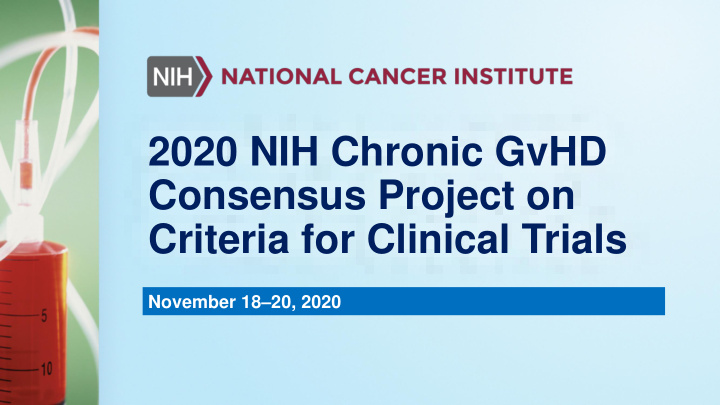



2020 NIH Chronic GvHD Consensus Project on Criteria for Clinical Trials November 18 – 20, 2020
WG2A: Clinical Implementation and Early Diagnosis Presenters: Carrie Kitko, MD Corey Cutler, MD, MPH, FRCPC
Financial Disclosure Carrie Kitko, MD: NONE Corey Cutler, MD: Janssen, Jazz, Generon, Mesoblast, Syndax, Omeros, Genzyme, Incyte - Paid advisor
Working Group Members Corey Cutler – Chair Ad Hoc Members Joseph Pidala – Co Lead Dermatology Geoff Cuvelier Ed Cowen Nosha Farhadfar Pulmonary Mary Flowers Guang-Shing Cheng Shernan Holton Greg Yanik Anita Lawitschka Ophthalmology Hélène Schoemans Sandeep Jain Eric Tkaczyk Zhonghui Katie Luo Yoko Ogawa Michael Stern Philipp Stevens
Diagnostic Challenges • NIH diagnostic criteria were developed for research purposes and not all transplant providers, and even fewer primary oncology providers use them in daily practice • Many patients do not meet current NIH diagnostic criteria until irreversible damage has occurred • Lack of prognostic markers for cGVHD development
Improving Clinical Implementation • Education of transplant providers (MD and NP/PA) • E tools: eGVHD app, scoring tools embedded in EMR • Improved education and engagement of the patient/caregiver in monitoring for symptoms • Assessment of cGVHD target organs at regular intervals, and accurate documentation of baseline • Schedule of recommended testing and link to paper worksheet • Improved utilization of remote monitoring and assessments • Telehealth visits • Video conferencing with local physicians
Early Diagnosis – Global Approach • Development of prospective observational studies that monitor patients closely for the earliest changes associated with subsequent development of cGVHD • Enroll pre or very early post, frequent serial monitoring, f/u – 2 years • Include clinical characteristics, PRO and biomarker assessments • Explore the potential of machine learning to potentially identify previously unknown associations that do not rely on a priori hypotheses based on currently known risk factors or patterns of disease • Current study through the CIBMTR • Future studies should incorporate emerging data from natural history studies
Early Diagnosis – Organ Specific Focus • Specific recommendations for organs with high morbidity • Skin/fascia, ocular and pulmonary • Similar approaches could be applied to other organs • Recommended clinical assessments • Frequency and when to refer • Research Goals • Biomarker discovery – both systemic and tissue specific • Validation of early signs of disease • Patient report symptoms • Diagnostic assessment – including new technologies • Remote patient engagement – ex. PROM, spirometry
Limitations • The goal is to identify cGVHD earlier in the disease course prior to irreversible organ damage • Goal is to design pre-emptive trials to prevent progression to more severe phenotypes • At present there is not evidence to prove that earlier treatment would prevent progression • Need for frequent testing and/or assessment by subspecialists • Possible in a research setting, challenging in day-to-day management
Summary of Recommendations Goal to recognize cGVHD earlier in the disease course through the following: 1. Improved engagement of both transplant non-transplant providers and patients/caregivers • Facilitated by technology 1) telehealth (remote physician/patient assessment) 2) teleconferences (remote multidisciplinary conferences) 3) electronic applications/reporting tools.
Summary of Recommendations Goal to recognize cGVHD earlier in the disease course through the following: 2. Identify early signs and symptoms of cGVHD associated with later progression to highly morbid forms of cGVHD • Development of natural history studies starting prior to HCT and continuing through formal diagnosis and disease trajectory • Exploration of machine learning to identify previously unrecognized risk factors and patterns associated with highly morbid cGVHD. Further refinement with data from NH studies 3. Research into prognostic markers in blood, tissue, fluid, imaging and functional testing is needed to identify actionable test results for potential pre-emptive therapy.
Discussion Points • Challenges to widespread clinical implementation of cGVHD assessments • HCT providers need better tools in a non-research setting • Practice difference among HCT centers • Some patient are always seen at HCT centers, others have a shared care model, typically with a local oncologist (or PCP) with less frequent follow-up at HCT center • Consider development of easy to navigate education model for local providers • Combination of telehealth visit between HCT provider and patient as well as on demand telehealth conference between local provider and HCT provider to discuss concerning sx
Audience Discussion
Recommend
More recommend